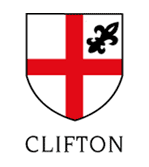Clifton School (South Africa)
| Clifton School | |
|---|---|
 |
|
| Location | |
|
Durban, KwaZulu-Natal South Africa |
|
| Information | |
| Type | Private school |
| Motto |
Prodese Quam Conspici (To accomplish without being conspicuous) |
| Established | 1924 |
| Locale | Urban |
| Executive Headmaster | Brian Mitchell |
| Exam board | IEB |
| Grades | 0–12 |
| Number of students | 800 |
| School color(s) | Red, Black and white |
| Head boys | L Mercouris and E Kraus |
| Website | www |
Clifton School is an independent school for boys located in Durban, Kwazulu-Natal, in the Republic of South Africa.
Mr Harry Stubbs, the retired first headmaster of Durban Preparatory High School (DPHS), established Clifton Preparatory School on 5 February 1924. His home, at 102 Lambert Road, provided the classrooms needed for the small numbers of boys who enrolled at the time. Although the school had at first been named ‘Stubbs’ School’, Mr Stubbs’s daughter, Dorothy, suggested the name ‘Clifton’, in memory of her cousin ‘Clifford’, who had been killed during the First World War.
Miss Stubbs taught Class One at Clifton until her marriage. Her position was filled by Miss Helen Fenell, who came from India. After a couple of years at Clifton, Miss Fenell also left to marry. She married Dr Joseph, and (as Helen Joseph), she went on to become a respected leader in the field of political activism against apartheid. She was placed under house arrest in 1962 and lived under a banning order for 23 years until she was 80, surviving anonymous gunshots and a bomb wired to her front gate. She died in 1992 at the age of 87.
Within two years, the school had an enrollment of 37 boys, ranging from Class One [Grade 1] to Standard Three [Grade 5]. In the early years, boarding was offered, and boys slept in dormitories housed in the upstairs verandas, which were enclosed at the time.
There were no sports fields at the time, and cricket and rugby were played at the Old Fort grounds adjoining Kingsmead. Athletics meetings were held at Mitchell Park, and swimming took place at the town or Beach Baths.
In 1938, with an enrollment of 60 boys, the school was purchased by Mr Kenneth Haworth, who succeeded in increasing numbers to 160 by 1942. He will be remembered for two far-reaching decisions: the founding of Clifton Nottingham Road in 1942, and the appointment of Anthony Greenwood Sutcliffe as his successor to head the Durban School.
Because of parents' concern over the possibility of enemy action, an air raid shelter was constructed at the school (later used as a changing room for the swimming pool).
Mr Haworth moved to ‘Spring Grove’, a farm that he purchased from Col. E.M. Greene at Nottingham Road, with almost half the boys, while Mr ‘Tim’ Sutcliffe took over the headmastership of the Durban School.
By 1945, Kenneth Haworth’s alcoholism made it impossible for him to remain at his post, and he was forced to sign an irrevocable power of attorney which authorized Tim Sutcliffe to form a Trust to continue the two schools. Mr Sutcliffe, a history teacher at Hilton College was 27 years of age, and had no previous experience of teaching in a preparatory school. The Clifton he came to was situated on just 1-acre (4,000 m2) of ground, and his staff consisted of six female teachers.
...
Wikipedia
